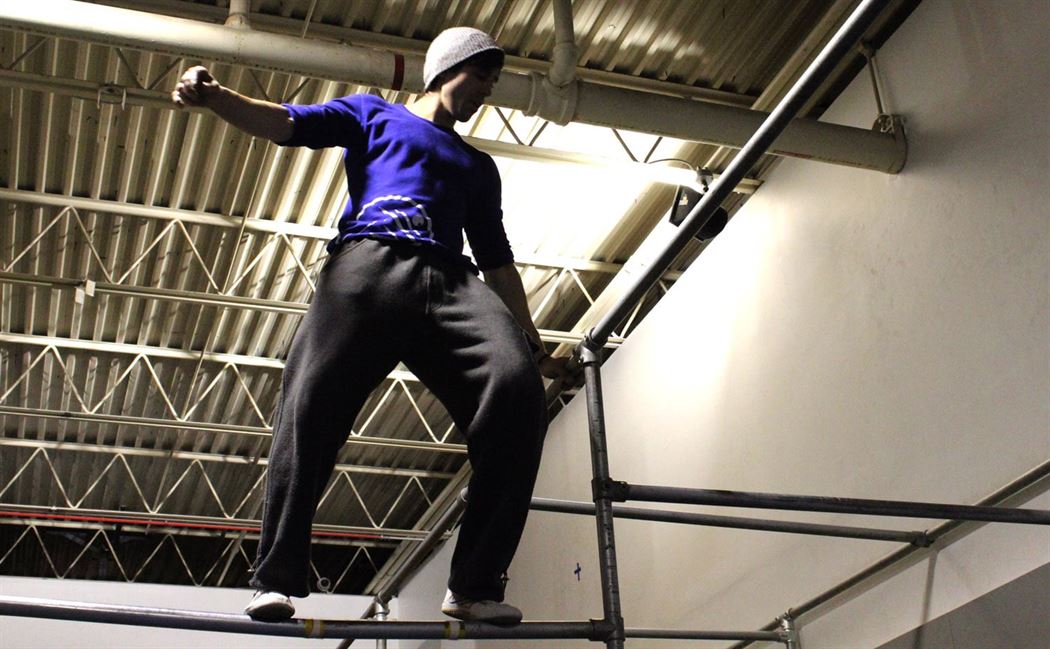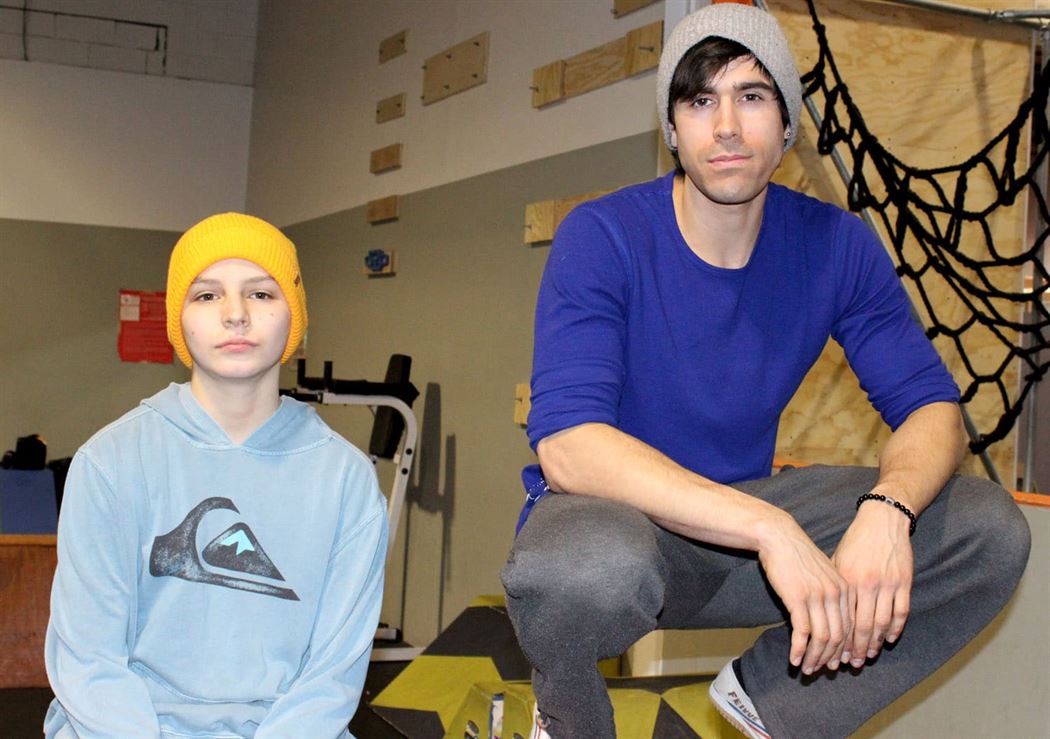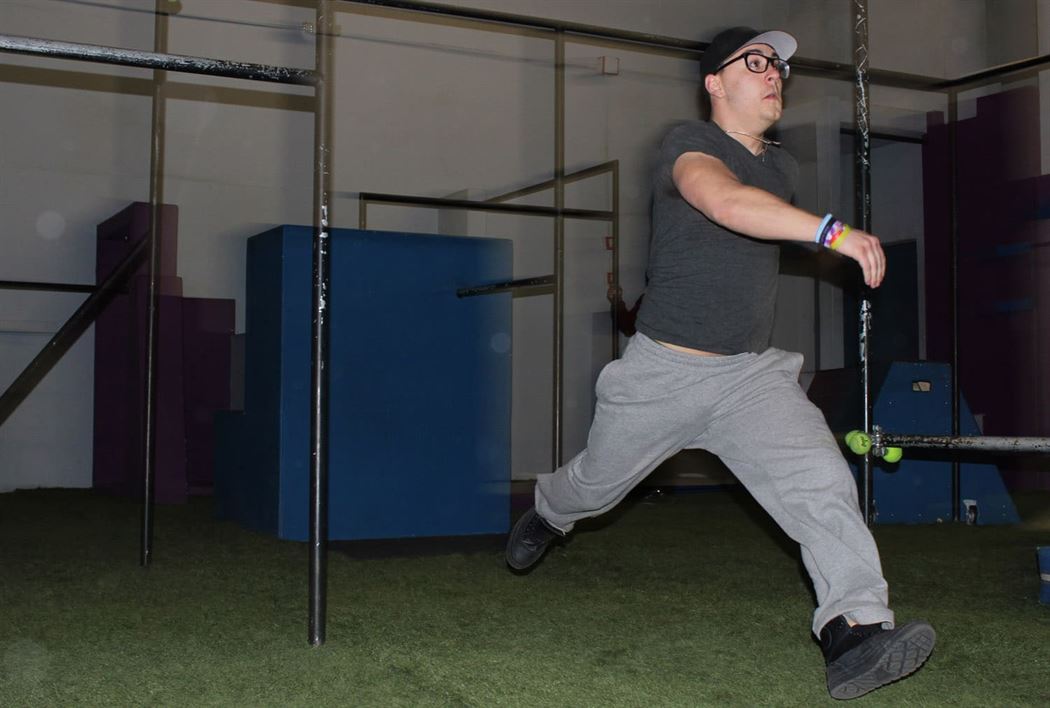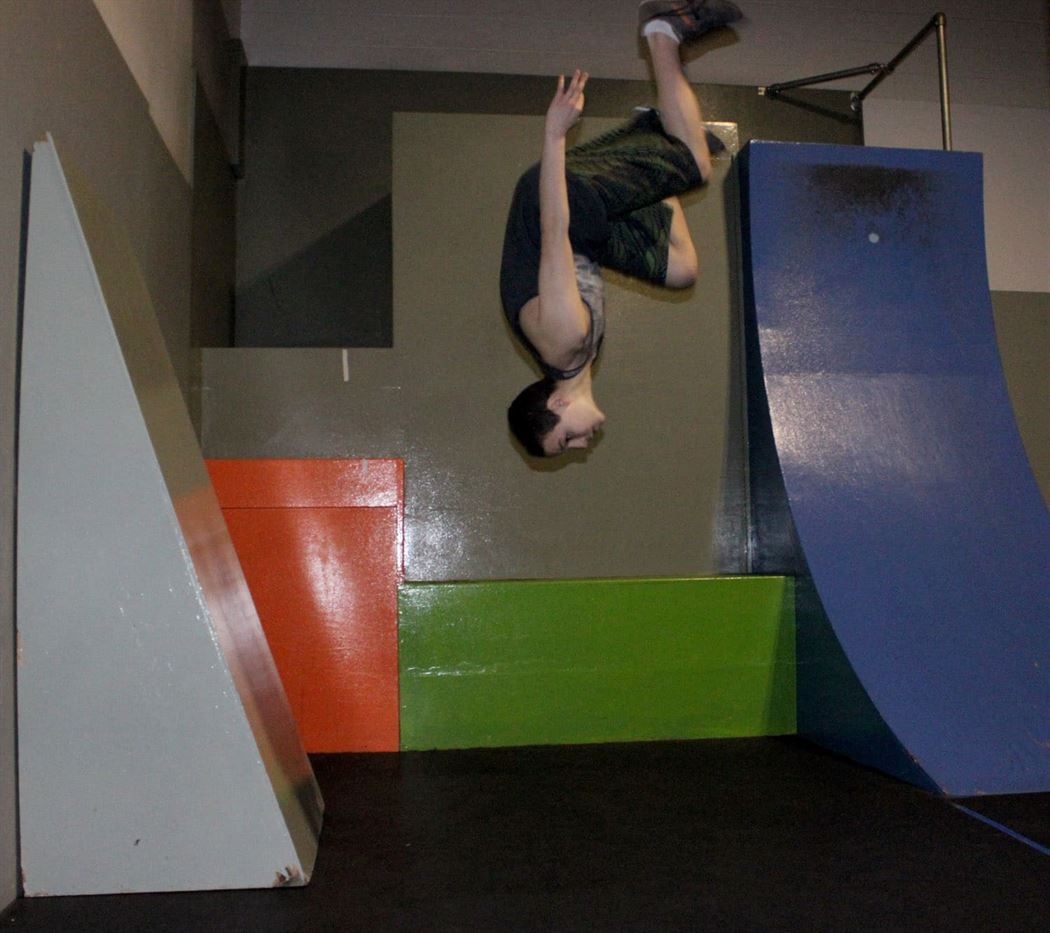
Parkour pro, Eric Rossi, balances on a high bar as he explains the intricacies of the sport.
Alexa Arrabito | The Montclarion
Parkour instructor, Eric Rossi of High Exposure Climbing Gym in Northvale, New Jersey, casually dressed in grey sweatpants and a blue shirt, jumps from the ground up on a vault box with ease. Some of his students follow his lead while also revealing what they learned in his classes. One of the students did a wall flip on one side of the gym and another jumped over some vault boxes, demonstrating what each could not do just a few months ago.
Rossi, the English major turned parkour instructor, moved from one vault box to the next with complete control—a clear statement that he is a long-time practitioner of parkour. While the students were admiring their instructor’s stunts, he continued to walk and crawl on the high bars at the far end of the gym. In passing, he mentioned that he used to practice the so-called “Cat Crawl” on the railings at the Montclair State University amphitheater with his friends.
Rossi, the 27-year-old Montclair State alumnus and a parkour instructor at High Exposure, teaches parkour classes for all levels. High Exposure also offers climbing and ninja warrior classes for all levels and ages.
Parkour, derived from French military course training, is the physical and mental discipline of overcoming obstacles, getting from one point to another without assistive equipment in the fastest and most effective way possible. It is becoming an increasingly popular sport. Many parkour gyms have been emerging across the nation and the greater New Jersey area has the greatest density of parkour gyms in the world. Plus, it is now considered an official sport in the United Kingdom.
Rossi is attracted to parkour because it feels good to accomplish difficult moves, such as getting a new vault down or getting up to the top of a wall.
“Reaching small goals and later the bigger goals gives great satisfaction,” Rossi said.

Coach Eric Rossi and student Kyle Guttman pose for a photo after a parkour session at High Exposure Climbing gym.
Alexa Arrabito | The Montclarion
One of Rossi’s students, Kyle Guttman, a 13-year-old aspiring parkour practitioner, has a slightly different view on the sport.
“Seeing your environment differently, more than just overcoming obstacles, it’s like instead of looking and walking through a way, you can kind of go over the walls,” Guttman said.
Practicing outside is the ultimate goal. Parkour essentially demands you to challenge yourself. Those who do it sometimes go out when it snows or rains to try to understand their limits and test their environment.
“Parkour is a safe way to challenge yourself,” Rossi said.
Rossi became interested in parkour when he watched a video by one of the modern-day parkour founders, David Belle. At the time, he was into cross-country trail running, which was kind of similar to parkour in terms of running through trees and off rocks. His interest grew to a point where he wanted to start a parkour club at Montclair State. That unfortunately didn’t become a reality.
They did, however, organize parkour jams with other universities in New Jersey, most notably Rutgers University and Rowan University.
“It was cool to have the whole New Jersey parkour community at one place, even people who weren’t in college,” Rossi said.
According to Rossi, many parkour athletes, especially as they start to get more serious and knowledgeable about the discipline, become more conscious about their food intake.
“Many of my parkour friends are very health conscious,” Rossi said. “They cook their own meals, don’t support energy drinks and include as much plants in their diet as possible.”
For Rossi, eating healthy and taking in nutritious foods is related to his fitness aspirations. Before he became a vegan, he didn’t pay attention to his eating habits and ate whatever his heart desired. He became a vegan three years ago and increasingly included plant-based foods in his meals.
“I look at food as medicine,” Rossi said. “You recover faster [when you eat healthy] and [being vegan] doesn’t affect my strength at all, unlike what other people might expect.”
When asked if parkour attracts certain types of people, Rossi hesitated before he answered. All types of people do parkour, however, he does take notice that many, including himself, are natural introverts. He also noted that many parents come to him saying that their children don’t like team sports, and as a result enroll them in parkour classes.
Guttman mentioned that some of his friends do parkour for the sole reason that it’s fun, but others do it for the disciplinary part of it. For them, it is important to reach their goals and overcome challenges.

With determination, first-time parkour student Nick Gencarelli bolts toward an obstacle at Pinnacle Parkour Academy in Princeton.
Alexa Arrabito | The Montclarion
Nick Gencarelli, 24, from Little Falls, New Jersey, wants to do parkour for fun. Gencarelli, a former athlete, immediately wanted to try it out after seeing parkour practitioners on television. At a practice session he attended at Pinnacle Parkour Academy in Princeton, New Jersey, Gencarelli reached the top of a short warped wall with ease after his first attempt.
“I think it’s really cool that [people that practice parkour] can do these crazy jumps and flips off of everyday objects that you would normally look at and be like ‘That’s a bench, that’s where you sit,’ but these people see it as something that I can jump off and do flips on and make it into something it’s not intended for, which is cool to me,” Gencarelli explained.
The different types of subcultures within the parkour community are also visible from the types of clothes parkour practitioners wear. The hat that Rossi was wearing was part of his personal style, but the grey sweatpants are common among practitioners. Sweatpants are a standard unofficial dress code, as well as leggings with shorts.
Rossi and Guttman explained that one comes across the extreme opposite too: people who wear extra baggy sweatpants. These people are usually a size medium, but get the double extra-large sweatpants, because it looks poofy and they flow with their movements. Others wear shirts that come halfway down to their thighs.
Still, the question remains: What is so appealing about parkour? Gabrielle B., the director of operations at High Exposure, doesn’t do parkour, but likes to watch other people practice it.
“People who like parkour are probably people who are interested in the adrenaline rush,” she said. “It takes great skill and incredible courage to jump from building to building and not get hurt.”

Aspiring ninja warrior, Kyle Guttman, flips off of a wall with ease at High Exposure Climbing in Northvale.
Alexa Arrabito | The Montclarion
Before parkour, Guttman said that he didn’t have many friends and that the feeling of being part of a community only increased his interest in parkour.
“I kind of made these life-long friendships [at the gym],” Guttman said. “Now I’m in this group at my school where everybody does parkour, and we always have something to talk about and it’s super fun.”


